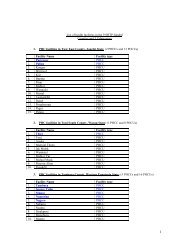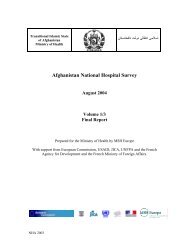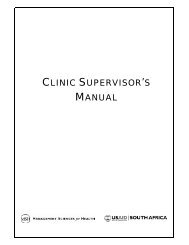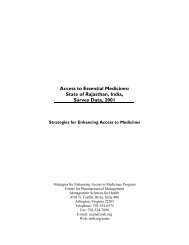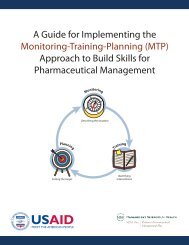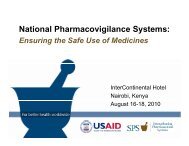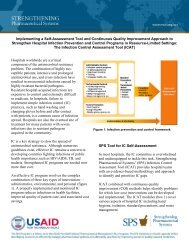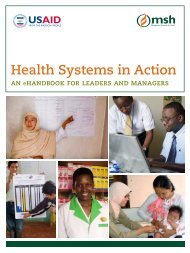Evaluation of Malawi's Emergency Human Resources Programme
Evaluation of Malawi's Emergency Human Resources Programme
Evaluation of Malawi's Emergency Human Resources Programme
Create successful ePaper yourself
Turn your PDF publications into a flip-book with our unique Google optimized e-Paper software.
Management Sciences for Health<br />
ELEMENT 1: IMPROVING INCENTIVES FOR RECRUITMENT AND RETENTION OF HEALTH<br />
WORKERS<br />
Overview <strong>of</strong> Implementation<br />
The 52% top-ups to the 11 priority cadres <strong>of</strong> staff were implemented nationwide at MOH<br />
and CHAM facilities beginning in April 2005. Although not part <strong>of</strong> the original plan, an<br />
additional cadre, the Health Surveillance Assistants (HSAs), also received top-ups under<br />
the EHRP. HSAs are salaried community-based health workers that deliver various<br />
services, including: immunisations, family planning, well-child visits, and disease<br />
surveillance. MOH targets for HSAs are 1 per 1,000 population (CHAM does not employ<br />
HSAs). The HSAs are recruited and trained within each district by the District Health<br />
Teams. Currently, the HSA cadre is divided into two cohorts: those in established posts, as<br />
determined by the DHRMD, and those in non-established posts, recruited on an indefinite<br />
basis by the Global Fund. The new cohort <strong>of</strong> non-established HSAs was recruited in 2007<br />
and received a 26% salary top-up. In response, established HSAs were also given 26%<br />
top-ups, beginning in October 2008.<br />
The recruitment and re-engagement strategy under Element 1 involved two large-scale<br />
recruitment galas, in June/July 2006 and November/December 2008. The galas were<br />
advertised nation-wide, and held over the course <strong>of</strong> five days in each district. In addition<br />
to recruiting new health workers, a major focus <strong>of</strong> the galas was re-engaging staff that had<br />
left, due to retirement or other reasons. To address these issues, the retirement age was<br />
increased from 55 to 60 years, and three-year contracts were <strong>of</strong>fered to health workers for<br />
re-engagement.<br />
As <strong>of</strong> the writing <strong>of</strong> this <strong>Evaluation</strong> report, the hardship package proposed under Element<br />
1 has not been implemented. No comprehensive plan has been developed detailing the<br />
components <strong>of</strong> the hardship package or how it would be implemented. This topic will be<br />
revisited in later sections <strong>of</strong> the report.<br />
Data and Findings<br />
A. Quantitative<br />
� Yearly targets were set at the inception <strong>of</strong> the EHRP (see Annex A). As <strong>of</strong> the end<br />
<strong>of</strong> 2009, four cadres have met or surpassed the yearly targets – physicians, clinical<br />
<strong>of</strong>ficers, laboratory technicians, and pharmacy technicians. 36 (Figures 3 – 6)<br />
� Physicians increased from 43 in 2004 to 265 in 2009; a 516% increase (Figure 3).<br />
(Refer to Table 5 for complete list <strong>of</strong> percent increases by cadre). 37<br />
36 Full details <strong>of</strong> MOH and CHAM cadres by year compared with targets can be found in Annex I.<br />
37 Note that the large percentage increase in physicians is due to the low starting figure <strong>of</strong> 43 physicians. In<br />
real terms, there was an absolute increase <strong>of</strong> 222 physicians over the EHRP. Nurses, by comparison, saw an<br />
absolute increase <strong>of</strong> 1,356 nurses during the same period, which was a 39% increase.<br />
EHRP <strong>Evaluation</strong> Final Report Page 23



